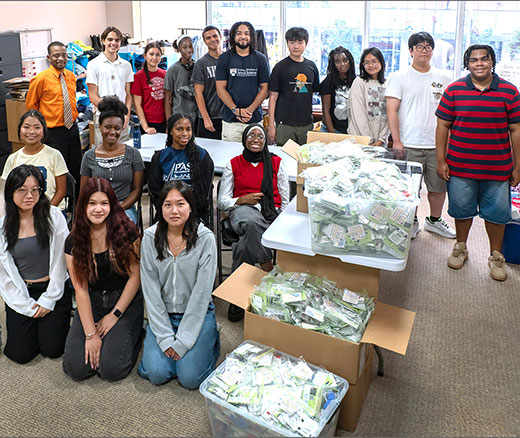
New Model Predicts Stimulant Overdose Risk Among Medicaid Patients
LDI Fellows Used Medicaid Data to Identify Individuals at Highest Risk for Cocaine- and Methamphetamine-Related Overdoses, Paving the Way for Targeted Prevention
Substance Use Disorder
Blog Post

In New York City, opioid overdose deaths continue in record numbers, and anyone can receive the free reversal drug naloxone from an Opioid Overdose Prevention Program (OOPP) or even a vending machine. You’ll see ads on subway cars, poles, and billboards with sayings like, “I Saved My Best Friend’s Life.”
But while OOPPs represent a prime tool for easing the overdose epidemic, are they in the right places? Are they where the need is greatest?
LDI Senior Fellows Elizabeth Nesoff and Zachary Meisel set out to answer that question by mapping the locations of overdose deaths and comparing them to the addresses of prevention programs in New York City in 2018 and again in 2020.
In their study, the team found that the distance from overdoses to programs significantly improved over those two years, with the average distance falling by about 1.7 miles, from 2.7 miles in 2018 to 1 mile in 2020. The proximity of programs to high-risk areas also increased in hard-hit areas of Manhattan and the South Bronx, though new programs may have helped further.
At the same time, the team discovered gaps in many areas, such as Brooklyn and Queens, suggesting places that should be a focus in the future.
“I was trying to get at the barriers the average person with no prior knowledge of how to get naloxone would experience, especially in terms of physical locations where it could be found,” Nesoff said. “If a person is looking for naloxone, there may be a sense of urgency. Expanding access at OOPPs is a promising strategy for increasing lay naloxone carrying as they may be friendlier environments where people can get naloxone at low or no cost without experiencing stigma.”
“However, it’s crucial that we do more research to understand how lay naloxone carrying translates into overdose reversal events and, ultimately, reduced overdose rates,” she added. “We need more and better data on nonfatal overdoses to fully understand how lay naloxone carrying impacts fatal overdose rates.”
The opioid epidemic claimed the lives of 3,026 New Yorkers in 2022, the highest since reporting began in 2000.
In response, the City of New York deployed several strategies to decrease overdose deaths. A cornerstone of the plan is to saturate the city with naloxone (also known by the brand name Narcan), a medication that can reverse opioid overdoses. With 78% of drug overdose deaths involving opioids, the use of naloxone by more people saves lives. There is significant evidence that OOPPs are effective at reducing overdose deaths and are cost-effective. So the City is considering expanding these programs, which distribute naloxone to laypersons, not just health care professionals or first responders. The City’s OOPPs target naloxone distribution to groups at highest opioid overdose risk, and provide a suite of harm reduction tools, such as needle exchanges, testing strips, and access to medication-assisted treatment.
New York City provides naloxone through multiple pathways including OOPPs, vending machines, and private pharmacies.
Despite the City’s efforts to promote naloxone access through pharmacies, a New York Times investigation found that only 30% of the 720 pharmacies the City listed for naloxone availability had it in stock. In addition, “pharmacies located in low-income, predominantly-minority neighborhoods, and neighborhoods with higher opioid overdose death rates are less likely to stock naloxone,” the authors noted, citing previous research from New York City and Philadelphia.
Costs represent another barrier for patients using pharmacies. In May 2024, the cost of over-the-counter naloxone was between $26 and $95 per box out-of-pocket according to the online site GoodRx.

Nesoff and Meisel found no significant differences in the distance to OOPPs based on race/ethnicity in 2018.
However in 2020, they observed that OOPPs were more likely to be located closer to Latino communities, suggesting that services were improving there. OOPPs were also more likely to be located in communities with higher poverty rates in 2020, suggesting improved access in communities that may not be served by other naloxone access points such as pharmacies.
In 2020, as overdoses increased in New York City and nationwide, OOPPs were better located in areas with higher opioid overdose rates compared to 2018.
Ending the overdose epidemic requires a multi-pronged approach, but access to life-saving drugs for communities that need them builds a strong foundation of harm reduction.
The study, “Neighborhood and Individual Disparities in Community-Based Naloxone Access for Opioid Overdose Prevention,” was published on January 9, 2024 in the Journal of Urban Health. Authors include Elizabeth D. Nesoff, Zachary F. Meisel, Huda Saeed, and Silvia S. Martins.


LDI Fellows Used Medicaid Data to Identify Individuals at Highest Risk for Cocaine- and Methamphetamine-Related Overdoses, Paving the Way for Targeted Prevention

Penn and Four Other Partners Focus on the Health Economics of Substance Use Disorder

Penn Medicine’s New Summer Intern Program Immersed Teens in Street Outreach Techniques

LDI Experts Offer 10 Solutions to Get More Help to Seniors With Addiction

More Flexible Methadone Take-Home Policy Improved Patient Autonomy
Research Brief: LDI Fellow Recommends Ways to Increase Availability